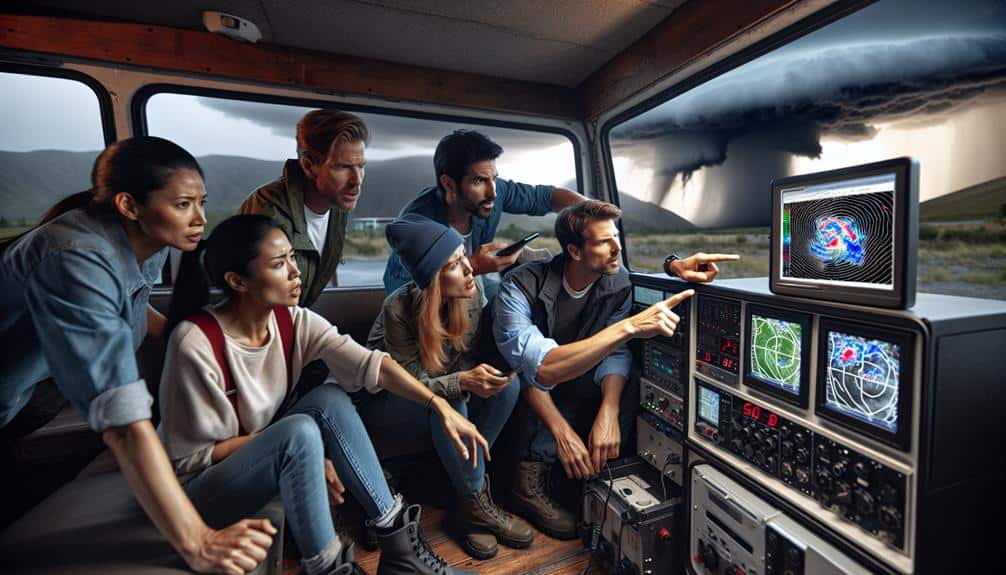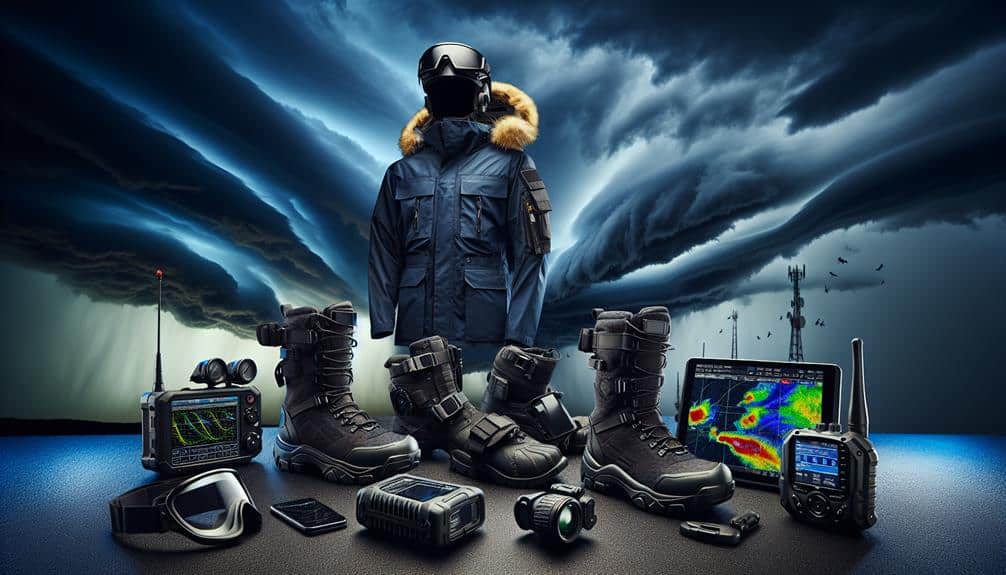Proper training is vital for novice storm chasers because it ensures our comprehension of storm dynamics, like wind shear and lightning patterns, essential for predicting severe weather. Handling necessary equipment, such as regularly calibrated anemometers and Doppler radar systems, guarantees accurate data collection. We need to master radar interpretation and establish escape routes for safe navigation. Emergency response skills, like first aid and evacuation drills, prepare us for high-pressure situations. Collaboration and advanced communication tools help us synchronize efforts and make informed, real-time decisions. Let's explore further to grasp how these factors collectively reduce risks and enhance our storm-chasing efficiency.
Key Points
- Proper training equips novice storm chasers to safely navigate severe weather conditions and mitigate risks.
- Training ensures accurate interpretation of radar data and understanding storm dynamics for informed decision-making.
- Safety protocols and emergency response skills reduce the chances of accidents and enhance preparedness during critical moments.
- Familiarity with equipment and its maintenance prevents technical failures and ensures reliable data collection.
Understanding Storm Dynamics
To accurately predict and safely navigate severe weather, we must first grasp the fundamental principles of storm dynamics, including the formation, structure, and behavior of different types of storms. Understanding storm formation requires analyzing atmospheric conditions such as temperature, humidity, and wind patterns. These elements interact to create the instability necessary for storm development.
Low-pressure systems, coupled with high moisture content and rising warm air, often lead to severe thunderstorms.
When examining tornado behavior, we need to focus on the specific atmospheric conditions that lead to their formation. Key indicators include changes in wind direction and speed with altitude, known as wind shear, which can produce the rotating updrafts essential for tornado genesis. By analyzing historical data and real-time information, we can predict tornado trajectories and intensities with greater accuracy.
Furthermore, lightning patterns provide essential insights into storm dynamics. The frequency and distribution of lightning within a storm can indicate its severity and potential for producing hazardous weather. High-frequency lightning often correlates with strong updrafts and significant precipitation.
Essential Equipment Handling
Proper handling of essential storm-chasing gear, such as anemometers, barometers, and Doppler radar systems, guarantees precise data collection and enhances safety during field operations. Our ability to effectively manage these tools hinges on rigorous training and strict adherence to equipment maintenance and safety protocols.
To exemplify the crucial nature of this task, consider the following key points:
- Calibration: Regular calibration of instruments like anemometers guarantees data accuracy. Without this, we risk inaccurate readings that could compromise both our research and safety.
- Inspection: Routine inspection of Doppler radar systems for wear and tear helps preempt malfunctions. This proactive approach is vital for reliable atmospheric measurements.
- Battery Management: Efficient battery management is essential. We must always carry charged backups to avoid operational downtimes during critical moments.
- Safety Protocols: Adhering to safety protocols, such as grounding equipment during lightning storms, minimizes the risk of electrical hazards.
In the dynamic world of storm chasing, our freedom to explore and document severe weather phenomena is directly tied to how effectively we handle our equipment. By prioritizing equipment maintenance and following safety protocols, we not only preserve our tools but also safeguard our teams, ensuring we can continue our missions unimpeded.
Exploring severe weather requires a thorough understanding of meteorological patterns and real-time data analysis to make informed decisions and guarantee team safety. We must master the intricacies of radar interpretation, wind shear assessment, and storm cell evolution. These elements are critical when executing risk assessments to determine the viability of a chase and to avoid unnecessary hazards.
Safety protocols are non-negotiable. We need to establish a detailed plan that includes predetermined escape routes, reliable communication systems, and constant monitoring of weather updates. Utilizing GPS technology, we can pinpoint our location relative to the storm's path, allowing us to navigate securely and efficiently.
Real-time data is indispensable. By integrating tools such as Doppler radar, storm spotter networks, and satellite imagery, we can analyze storm behavior in real-time. This data-driven approach enables us to predict potential changes in the storm's trajectory and intensity, ensuring we can swiftly adapt our positioning.
Ultimately, the freedom to chase storms comes with the responsibility to prioritize safety. Rigorous training in understanding severe weather ensures we're prepared to make decisions that protect both our team and the public, reinforcing the core principle that knowledge is power in storm chasing.
Emergency Response Skills
In the unpredictable realm of storm chasing, mastering emergency response skills is vital for mitigating risks and ensuring swift, effective action during pivotal situations. We need to be prepared for any eventuality, as our well-being and the success of our mission depend on it.
Engaging in practice scenarios regularly allows us to simulate real-life emergencies, refining our responses and decision-making processes.
Here are four crucial components of effective emergency response training:
- Simulation Drills: Repeated practice scenarios help us internalize emergency protocols, ensuring we don't falter under pressure.
- First Aid Proficiency: Immediate medical attention can be essential. Comprehensive first aid training equips us to handle injuries or medical emergencies until professional help arrives.
- Evacuation Procedures: Knowing the quickest, safest evacuation routes can mean the difference between safety and peril. We must rehearse these procedures frequently.
- Team Building: Cohesive teamwork is essential in high-stress situations. Team building exercises foster trust and coordination, enhancing our collective response efficacy.
Collaboration and Communication

Effective storm chasing relies on our ability to maintain seamless collaboration and clear communication, essentially allowing us to share vital information and make informed decisions in real-time.
Teamwork is the foundation of our operations, requiring us to synchronize our efforts and execute a unified strategy. When we're in the field, each team member's role is defined to maximize efficiency and minimize risk. For example, while one of us monitors radar data, another might be responsible for navigation, making sure we position ourselves effectively relative to the storm.
Utilizing advanced communication tools, such as encrypted radios and real-time data-sharing platforms, allows us to stay connected despite challenging conditions. These technologies enable us to relay our observations and receive updates from meteorological agencies, which is essential for adapting our strategy dynamically. Data-driven decision-making empowers us to predict storm movements accurately and adjust our positioning accordingly.
Moreover, regular training drills simulate real-world scenarios, enhancing our ability to function cohesively under pressure. This practice not only strengthens our individual skills but also reinforces our collective capability to tackle unforeseen challenges.
Essentially, collaboration and communication aren't just operational imperatives; they're the key elements that guarantee our safety and efficacy in the field.
Frequently Asked Questions
What Are the Potential Psychological Impacts of Storm Chasing?
We've observed that storm chasing can exert a significant emotional toll, affecting mental health. Effective stress management and coping strategies are paramount to mitigate these impacts, allowing us to maintain our psychological wellbeing amidst the high-adrenaline environment.
How Do Storm Chasers Balance Safety With the Thrill of the Chase?
We balance safety with the thrill of the chase through meticulous risk management. The adrenaline rush is undeniable, but we use real-time data, predictive models, and strict protocols to guarantee our pursuit doesn't compromise our safety.
Are There Ethical Considerations in Storm Chasing?
We face ethical dilemmas in storm chasing, balancing our freedom with the environmental impact. Data shows our activities can amplify ecological disturbances, necessitating responsible actions. Ethical guidelines help mitigate these effects while still allowing pursuit of our passion.
What Kind of Physical Fitness Is Required for Storm Chasing?
Storm chasing is like a marathon with obstacles. We need endurance training for long hours and strength training for handling equipment. Data shows that chasers with better fitness levels can react faster and navigate challenging terrains more effectively.
How Do Storm Chasers Stay Updated With the Latest Weather Technologies?
We constantly stay updated by leveraging the latest weather forecasting tools and radar technology. By analyzing real-time data and trends, we can predict storm patterns accurately, ensuring our safety while maximizing our freedom to explore.


